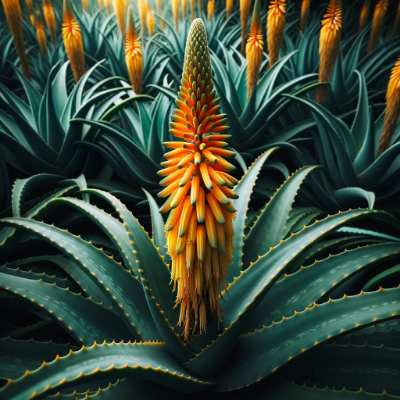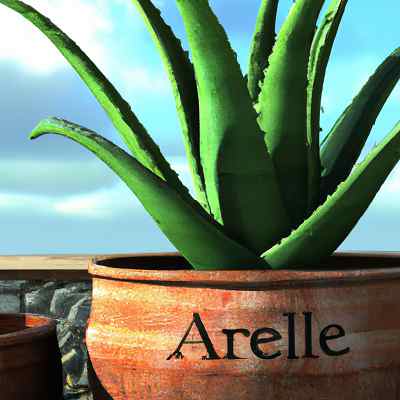Aloe is a flowering succulent that produces colorful blooms on tall stalks. If your aloe is flowering, enjoy the show! But be sure to take care of your plant to ensure that it continues to thrive.
What to do when aloe is flowering? When you see your aloe plant flowering, it means the plant is healthy and happy. To ensure continued good health, check your flowering aloe for signs of pests or diseases. Common pests to watch out for include mealybugs, aphids, whiteflies and spider mites. These can cause wilting, yellowing and other discoloration of leaves.
below I will explain about the various questions and what are the basic things to check and what exactly you should do when aloe is flowering.
What to do when aloe is flowering?
Plant Care
Aloe is a beloved succulent that produces charming colorful flowers when in bloom. This is a great sight to see, but it does take some special care to make sure that your aloe plant continues to thrive. This article will discuss the importance of proper plant care for when your aloe plant is flowering. Topics will include sunlight and water requirements, fertilizers, and pests.
Check for signs of pests or disease
When you see your aloe plant flowering, it means the plant is healthy and happy. To ensure continued good health, check your flowering aloe for signs of pests or diseases. Common pests to watch out for include mealybugs, aphids, whiteflies and spider mites. These can cause wilting, yellowing and other discoloration of leaves.
If you find any signs of pest infestation, remove any affected leaves by cutting them off just above the soil line with a sharp blade or scissors. Inspect checked leaves for any further signs of disease and dispose of them safely. If you have severe insect infestation across multiple plants, chemical insecticides may be necessary as a last resort to save the entire collection from damage from these pests.
Additionally, monitor your aloe plants for any fungal diseases such as black spot fungus or powdery mildew — these can diminish the plant’s natural beauty and slow down its growth if not treated promptly. Prune the affected parts and apply fungicide according to manufacturer instructions in order to prevent spread of infection throughout your plants.
Finally, make sure you water your flowering aloes sufficiently once every few days – depending on local climate – so that they receive adequate hydration while their flowers are blooming. Consider adding extra nutrients via organic garden fertilizers as well in order to provide optimum nourishment during this growth period which can be quite demanding on the plant’s resources!
Monitor soil moisture
It is important to keep tabs on the soil moisture of your aloe when it is flowering. Aloe vera, like many other succulent plants, is somewhat drought tolerant and does not need to be watered frequently. However, during the flowering period, soil moisture should be monitored closely. The aloe vera can benefit from a soil dampness of medium-moisture levels and an occasional deep soak every couple weeks. Be careful not to overwater your aloe during this time as it can lead to root rot or disease that can kill the plant.
Check the soil regularly and inspect for signs of contact with water sources such as condensation or humidity in the air. If you notice any standing water in the pot, remove immediately and water only when truly necessary. Examine plant leaves regularly for signs of stress— brown tips may indicate overwatering, while brown spots may indicate nutrient deficiencies or pests/disease.
Fertilize as needed
Aloes generally do not require frequent fertilizing if grown in well-drained soil that is composed of equal parts potting soil, coarse sand or perlite, and organic material such as peat moss or compost. Fertilize your aloe with a balanced fertilizer (10-10-10) applied at half- to one-third-strength once a month throughout the summer and early fall when the plant is actively growing. A slow release liquid fertilizer can also be used according to package directions. To reduce the likelihood of root burn, make sure to water the plant adequately before applying fertilizer. Overall, do not overfertilize aloe plants; too much nitrogen will produce soft growth that is more prone to disease and insect invasion than healthy plants.



Pruning
When aloe is flowering, it can be a great sign that the plant is healthy. To continue to keep the plant healthy, it is beneficial to prune the flowering parts of the aloe. Pruning can help to encourage the growth of more flowers and may also help to strengthen the structure of the aloe. As with any kind of pruning, there are certain considerations to keep in mind. Let’s discuss the best practices for pruning an aloe that is flowering.
Cut off any dead or damaged leaves
When pruning aloe plants, it’s important to remember the plant’s natural growth habits. Start by identifying and cutting off any dead or damaged leaves. Look for any browning or discoloration of the leaves, or if the edges are torn away. This is especially important for larger specimens of the aloe vera plant as it can become hazardous if left unchecked. Pruning not only eliminates worn out foliage but also promotes better air circulation and more uniform growth.
Next, check for flowers and cut off any that are starting to show. Aloe’s flowers will start out small – a pointed bud just above the surface of the soil – but they quickly grow bigger and spread out around the base of the plant along its stem. It’s best to prune these before they open up, as carried seeds will encourage new plants to sprout. You can also cut away old flower stalks that have already dropped their petals if you want to tidy up your aloe further.
Finally, when caring for your alooe you may want to reduce its size slightly by carefully trimming some of its longest leaves near their base. While this doesn’t technically constitute pruning per se, it will help keep your plant at a manageable height and density while still maintaining its wild aesthetic beauty! To keep things balanced while trimming, try removing one leaf every few weeks over several months rather than cutting multiple leaves all at once – that way you won’t be chopping off precious nutrients your Aloe needs!
Trim away any brown or yellow leaves
When pruning aloe, you should look at the entire plant and trim away any brown or yellow leaves. When trimming back leaves, make sure you cut where the leaf meets the stem so that you don’t damage the part of the plant that will continue to produce new growth. For aloes that are already blooming, you can safely trim away any flowers that have dried up and are not producing nectar or pollen.
You should also inspect your aloe for signs of disease or pest infestation, such as wilted leaves or black spots on the leaves or stems. If detected, take appropriate measures to treat it. If a severe infestation is present, it may be best to remove affected plants from your garden altogether to prevent spread of disease to healthy plants.
By consistently monitoring and inspecting your aloe plants for any signs of trouble, you can ensure they stay healthy and vigorous for years to come!
Cut off any flower stalks
Once your aloe has reached a mature size, it may produce flowers. Pruning aloe vera when it’s flowering can help keep the plant looking tidy and encourage it to bloom again. Cut off any flower stalks as soon as they emerge and there will be fewer new buds and flowers on the plant. Although cutting off flower stalks will not harm your aloe, be sure not to get overzealous with your pruning – it’s best to leave some of the older flowers, which contain the essential oils that give aloe its medicinal properties.
When you remove flower stalks from an aloe, be sure to use a pair of clean garden scissors or shears; this will ensure that there is no disease spread between plants. First, spread out the center portion of the burrito shaped stalk then cut off as much of the stalk as possible using a sharp pair of garden scissors. For best results, make sure to prune at least 4 inches along stem so that all parts have been removed.
After you cut off a flowering stem, you should cut back some of the larger leaves near it and any foliage that is dead or diseased. Some smaller leaves can simply be plucked away if need be. It’s important to keep surrounded with healthy foliage during propagation process in order for continued development and growth in later stages . Doing so removes excess energy load away compromised leaves or stems allowing for better absorption loading for dependent leaves for improved photosynthesis performance especially in those tightly clustered areas where too much shade can impede natural light absorption underneath dense umbrellas of foliage above canopy line height shadows
Watering
Watering is one of the most important things to consider when your Aloe plant is flowering. Over-watering is a common mistake among Aloe growers, and it can lead to root rot and other problems. It’s important to find the right balance when watering your Aloe flower. The soil should be completely dry between waterings and the Aloe should be in a well-draining pot to avoid root rot. Let’s look into some more details about watering Aloe when it’s flowering.
Water deeply and infrequently
When aloe is flowering, it is important to provide your plant with adequate water. Aloe plants should be watered deeply and allowed to dry out in between watering. The best way to water aloe is to give it a good drenching every two weeks or so, allowing the soil to dry out completely in between waterings. This helps promote strong root growth and keeps the plant from becoming soggy. It’s also important to remember that aloe plants will use more water when they are flowering, so you may need to adjust your watering schedule accordingly and pay close attention to how the soil feels. If the soil dries out quickly or feels very light when you pick up the pot, it may need more water sooner than you were originally planning for.
Make sure the soil is not soggy
When aloe is flowering, it is important to make sure the soil is not soggy. Aloe plants require soil that has good drainage to ensure they stays healthy and continue to bloom. Too much water can cause root rot, which can result in decreased blooms and an unhealthy plant.
Be sure to water your aloe plant deeply, but infrequently so it can absorb what it needs at the root level without the roots sitting in moisture for extended periods of time. Depending on the size of your pot and how quickly the soil dries out between waterings, give your aloe with 1 – 2 cups (or 1/2 – 3/4 of a liter) of water every other week or as needed. Allow the top one to two inches (3-5 cm) of soil to dry out before giving it another drink. If you are unsure if your aloe needs more water, check just below the surface for moisture before offering a drink and avoid overwatering!
Avoid overwatering
During the flowering period, reduce watering to prevent overwatering. Aloe plants need less water during this time to ensure optimal growth and health. When watering your aloe during this time, avoid soaking the leaves and apply just enough moisture to keep the soil lightly moist. Check your aloe ofter as even with reduced water, it is possible to overwater your plant. Monitor its appearance; if the leaves turn yellow or develop brown spots or patches, your aloe may need less water or better drainage in its pot.
Light
When aloe is flowering, it is important to provide the right lighting for the flowers to thrive. Most aloes need bright sunlight to flower, so it’s important to make sure your aloe is getting at least six hours of direct sunlight a day. You can also place your aloe in a sunny spot during the afternoon, but make sure to move it to a shadier spot in the late afternoon. This will help ensure that your aloe flowers get the light they need.
Place the aloe in a bright, sunny spot
When your aloe plant is flowering, it needs plenty of direct sunlight to keep blooming healthily. Place it in a sunny spot indoors or in a pot on an outdoor patio with access to full sun. Allow the soil to dry out between watering and make sure it’s not sitting in an overly wet environment. Keep nighttime temperatures around 65°F-75°F and daytime temperatures between 80°F-90°F for optimal flowering health. When flowering has finished, you can move the potted aloe back into its original site or leave it where it is as long as you’re providing the plant with these needed conditions. As aloe thrives best in dry climates, make sure that the area has good air circulation and never overwater or flood the potting mix.
Avoid direct sunlight during the hottest part of the day
Most aloe plants like bright, indirect sunlight. During the hottest part of the day when the sun is at its most intense – typically between 11 a.m. and 2 p.m. – try to avoid direct sunlight on your plant. Direct sunlight should be avoided at all times during an aloe’s blooming period, as these intense rays can scorch some of its youngest and most delicate leaves, preventing them from flourishing in the future.
If your aloe is placed in a sunny window, you can lower the risk of scorching by closing blinds or shades to provide additional cover from the intensity of the light outside. If possible, consider moving the aloe to a general area that gets some natural light during parts of the day but is not in direct view of any windows or doors that may let in sun-rays at peak times such as 11 a.m.–2 p.m.. Placing your plant in this less sunny location – like on a partially shaded balcony or terrace – will also ensure it does not receive too much heat from reflected brightness during those sensitive hours.
Temperature
When it comes to aloe plants flowering, temperature is an important factor to consider. Aloe plants need a hot and dry environment in order to flower. If the temperature around the plant is too low or too high, it will not be able to flower. You should make sure to monitor the temperature around the plant to ensure it is within the ideal range. Let’s look at how temperature affects aloe plants when it comes to flowering.
Keep temperatures above 55°F
When aloe is flowering, it’s important to keep the temperature in its growing environment above 55°F (13°C). If temperatures dip below that, like they do during winter nights, the flower buds will be damaged. It’s best to keep the plant indoors or in a greenhouse if possible. Also make sure that it has access to bright but indirect light since too much direct sunlight can be damaging.
Aloe grows best when temperatures stay between 68-86°F (20-30°C). When temperatures are too high and there isn’t enough humidity in the air, the tips of the leaves can start to turn brown. To prevent this from happening, be sure that your aloe is in an area with good air flow and water it when necessary – but only enough so that its soil stays slightly moist.
Avoid cold drafts and extreme temperatures
Aloe shoots and flowers can be damaged by both cold drafts and extreme temperatures. To prevent damage, it is best to keep your aloe away from open windows, doors and heating/air conditioning units. Drafts may cause the leaves to droop or even die, while extreme temperatures can cause leaves to scorch or dry out.
When caring for a flowering aloe, be mindful of its location. During the summer months when days are hot, it’s especially important to avoid direct sun during peak hours (10am-2pm). The plant should not be exposed to temperatures over 105 degrees Fahrenheit; if possible try to keep your aloe near an east-facing window or in a shaded area outdoors where it won’t get too much direct sunlight.
During times of cold weather, make sure your aloe is not exposed to temperatures below 40°F (4°C) as this may lead to permanent damage and leaf drop. While certain species of aloes can survive moderate frost, the consequences of extreme cold vary significantly with species. To avoid damaging your beloved plant’s delicate cells by freezing or frosting them, ensure that they stay indoors if night time temps are forecasted to dip below 40°F (4°C).
Know more about Aloe vera flower.
This flowering can be lucky for you Click here to know more.
